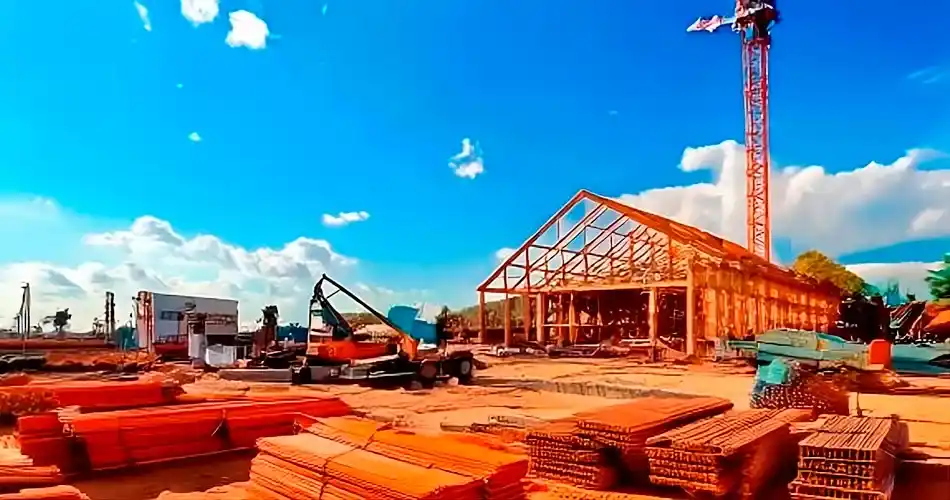Minimizing waste and maximizing efficiency
A circular economy (CE) is based on the principles of designing out waste and pollution, keeping products and materials in use, and regenerating natural systems, as defined by the Ellen MacArthur Foundation. The construction sector, according to UNEP, is responsible for 37% of greenhouse gas emissions, making it a prime candidate for circular economy practices. With urban populations projected to grow significantly by 2050, construction is anticipated to expand, presenting both challenges and opportunities. The buildings sector is included in the EU’s Circular Economy Action Plan and Taxonomy Regulation, which set ambitious goals for sustainability and climate neutrality by 2050. These policies not only encourage reduced resource use and waste but also emphasize flexible, long-lasting designs. For companies in construction, integrating CE practices is no longer optional but essential to align with EU standards and achieve both environmental and economic gains.
EU regulations supporting circular economy
Recognizing the need for sustainable transformation, the European Union has put in place several policies aimed at embedding circular principles into the construction industry. Several recent EU regulations provide the framework for a circular construction industry. The Circular Economy Action Plan (2020), a cornerstone of the EU’s Green Deal, encourages sectors to incorporate circular principles. The plan specifically highlights construction, setting a target to recycle 70% of non-hazardous construction and demolition waste in 2020, with member countries pushing beyond this threshold. Furthermore, the EU Construction Products Regulation (CPR), is pushing the sector toward eco-design, ensuring products meet environmental standards, materials are renewable, low-carbon, and safe for reuse.
This regulatory framework aligns with the EU’s ambition for climate neutrality by 2050. For SMEs in construction, this offers a unique opportunity to adopt circular practices that not only help meet regulatory standards but also position them as sustainability leaders in the marketplace. Meeting these regulations can provide a competitive advantage and fulfill growing customer demand for eco-friendly construction practices.
In the next part, discover technologies and strategies related to circular economy.
Technologies and strategies help companies become more sustainable
The circular economy (CE) is transforming the construction sector by reducing waste and optimizing resource use. With innovative technologies and sustainable strategies, companies can build more responsibly while improving efficiency and lowering costs.
Material Reuse and Recycling
Construction activities are significant sources of waste and environmental impact. However, by reusing materials from demolition and embracing recycled materials, the industry can significantly reduce its environmental footprint. To minimize environmental impact, the construction industry is increasingly turning to recycled concrete and bio-based materials like sustainably sourced timber and mycelium-based composites. Recycled concrete can lower CO₂ emissions by up to 50% compared to new concrete, while bio-based materials provide additional benefits – timber, for instance, acts as a natural carbon sink, and mycelium-based composites offer a renewable, lightweight alternative with a low environmental footprint. These innovative materials play a crucial role in reducing the reliance on energy-intensive, traditional construction resources. The potential for impact is immense. According to a 2024 report by the European Commission’s Joint Research Centre (JRC), construction and demolition waste (CDW) accounts for almost 40% of all waste generated in the EU. The study estimates that approximately 83% of CDW can potentially be recycled or prepared for re-use. Achieving this potential could lead to annual savings of 33 to 52 million tons of CO₂ equivalent, which is comparable to the combined annual emissions of Estonia, Latvia, and Luxembourg.
The Ellen MacArthur Foundation estimates that emissions associated with construction materials could be reduced by 38% by 2050 with circular strategies.
Modular and Prefabricated Construction
Modular construction is a fast-growing trend in the industry. Modular and prefabricated construction methods allow parts of a building to be manufactured off-site in controlled environments. This approach minimizes waste by optimizing the use of materials and reducing on-site errors. Not only do modular methods cut down on waste, but they also allow for parts to be easily deconstructed and repurposed in other projects. The benefits extend to shorter project timelines and lower costs, as materials are used more efficiently, and assembly times are reduced by up to 50%. Modular buildings are also designed for adaptability, meaning they can evolve as needs change or be repurposed entirely. This flexibility aligns perfectly with the circular economy ethos by reducing the need for frequent demolitions and rebuilds.
Extending the usage phase of buildings
A central goal of CE is to extend the operational lifespan of buildings through effective maintenance, repurposing, and renovations. Many companies are using digital twins—digital replicas of physical assets—to monitor building health and predict maintenance needs. These insights allow for proactive repairs that extend the building’s life while reducing material waste. To further support building longevity, some firms are adopting product-as-a-service (PaaS) models, where components such as lighting, facades, or flooring are leased rather than sold. This model provides maintenance and upgrades over time, maximizing component use and reducing the demand for new materials.
Digital tools for resource optimization
Digital tools play a key role in optimizing resources in construction:
- AI-powered platforms help monitor material usage, ensuring resources are efficiently ordered, used, and stored. This reduces waste and boosts efficiency by providing real-time operational insights.
- IoT and Smart sensors track building performance, energy use, and water and air quality. They provide data to improve efficiency and reduce waste. These devices also enable predictive maintenance, addressing issues early to extend a building’s lifespan and save resources.
Lifecycle assessment (LCA) and circular design
A building’s impact on the environment extends far beyond its initial construction phase. Lifecycle assessments (LCAs) allow companies to measure the environmental impacts of a building across its entire lifecycle, from raw material extraction to disposal. LCAs support circular economy goals by identifying areas where materials can be replaced with more sustainable options, reducing carbon footprints in the process. Circular design principles also support end-of-life material recovery, ensuring buildings can be dismantled and their materials reused rather than wasted. For example, the use of screws instead of permanent adhesives allows materials to be disassembled and repurposed easily, extending their lifespan and maximizing their value within the economy.
A real example: The Madaster Platform in the Netherlands
The Madaster Platform is an innovative initiative from the Netherlands that exemplifies the principles of the circular economy in the construction sector. Central to the platform is the concept of material passports—detailed digital records of all materials used in a building. These passports capture information about the type, quantity, quality, and location of materials, transforming buildings into repositories of valuable resources rather than sources of waste. This approach ensures that materials can be easily recovered and reused at the end of a building’s lifecycle, supporting a shift from traditional linear construction models to circular practices. Madaster also promotes transparency and traceability, providing stakeholders such as architects, contractors, and property owners with precise data about the materials within their buildings. This transparency not only facilitates sustainable decision-making but also assigns a residual value to materials, creating financial incentives for their reuse. By doing so, the platform encourages viewing buildings as “material banks” with economic value that extends beyond their primary use. Through its integration with building information modeling (BIM) systems, Madaster ensures that material data remains accurate and accessible throughout a building’s lifecycle. It also provides tools to assess environmental impacts, such as embodied carbon, enabling stakeholders to align their projects with sustainability goals and regulations. This functionality makes it easier for construction projects to meet the ambitions of the Dutch Circular Economy Program, which aims for a fully circular economy by 2050. The platform has been successfully applied to various projects in the Netherlands, including government and commercial buildings, where it has facilitated the recovery and reuse of construction materials. By fostering collaboration between developers, municipalities, and material producers, Madaster creates a cohesive ecosystem that supports circular construction. Its success underscores the potential of digital innovation to drive sustainability in traditional industries and serves as a model for implementing circular economy principles worldwide.
The future of circular economy in construction
As the construction sector faces pressure from both regulators and clients to adopt sustainable practices, the circular economy offers a clear path forward. The growing role of cleantech solutions will continue to bridge the gap between sustainability and efficiency, offering innovative ways to meet EU standards and customer expectations alike. Adopting these practices not only aligns with regulations but also taps into the demand for greener solutions, positioning construction firms at the forefront of a rapidly evolving sector. For businesses looking to future-proof their operations, investing in circular economy practices today can yield significant environmental and economic returns tomorrow. The transition to a circular construction industry is gaining momentum, with companies that act quickly standing to benefit most from the emerging opportunities.
Daniel has 20 years of experience in business and financial journalism, having worked in Zurich, Tokyo, Buenos Aires, and Mumbai. Over the years, he has covered start-ups, cleantech, and the Swiss construction sector in depth.
Deeply concerned about environmental issues and fully aligned with Raphaël’s vision of making the ecological transition more accessible and impactful for companies, he joined the project and co-found GoEko alongside him.




